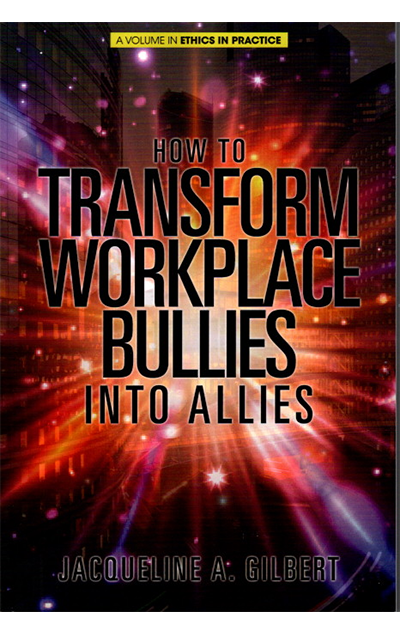
With this book, the author, Jacqueline Gilbert (Professor of Management, Middle Tennessee State University), starts the reader on a journey toward mastery. It’s an invitation for employers to DO something about bullying vs. traditional indifference and denial.
I cannot overstate the comprehensiveness of Gilbert’s coverage of the bullying phenomenon in this book. She leads readers through profiles of bullies – the perpetrators — and targeted individuals, the workplace culture that enables bullying, bystanders, top management support for eradication, and aspirational features of an ideal “people-centered” culture. Breadth is coupled with a realistic touch certain to appeal to modern readers accustomed primarily to truncated social media communication and visually appealing stimuli. She does not preach or over-teach.
Gilbert identifies all the resources for readers. She found the research. But don’t be fooled by the ease of access to information. Take the deep dive into each bullying sub-topic masterfully designed for you in the study and rehearsal exercises. Only then will readers glean the best outcomes from the book. Slow down. Incorporate the lessons taught to the practitioner-readers eager to stop bullying.
Frequent self-assessments force readers to confront personal beliefs that may can to mis-perceptions and misunderstandings at work. Readers have the chance to gauge the role of personal envy, toxicity of your workplace culture, bystanders status, problem-solving orientation, flawed unilateral communication styles, cyberbullying experiences, organizational inclusivity, and styles of conflict resolution. Stalking or “gang stalking” appears to be on the rise. Gilbert wisely acknowledges its ubiquitous emergent presence.
We learn in chapter 8 about the routinization of negative acts against others, dubbed “cultural stoning” — micro-inequities and micro-aggressions that recipients easily detect, but witnesses who do not share the others’ status normalize and miss. Extrapolating from the dyadic interaction to the dichotomous organizational response — as either reactive/apathetic or proactive/unifying — is brilliant.
In an accordion-like demonstration of intellectual range, each chapter flexes from teaching to extended study before collapsing back to the focus on what can be done practically. The outcome is the biggest take-away from each chapter and the book in total. The book helps answer the “So what?” questioning by those skeptical that bullying matters.

